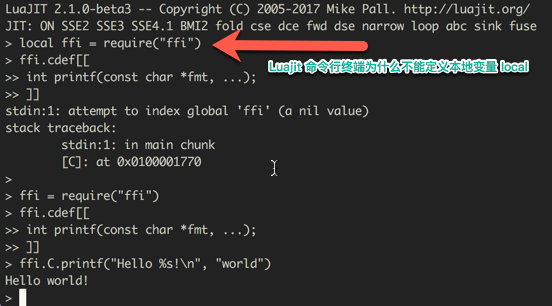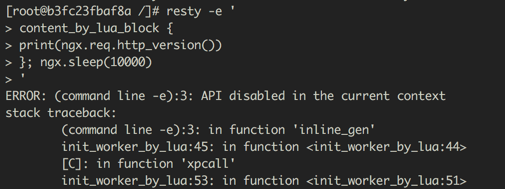 2019-07-08老师,文中的这句“OpenResty 的 HTTP 状态码中,有一个特别的常量:ngx.OK。当 ngx.exit(ngx.OK) 时,请求会退出当前处理阶段,进入下一个阶段,而不是直接返回给客户端。”
2019-07-08老师,文中的这句“OpenResty 的 HTTP 状态码中,有一个特别的常量:ngx.OK。当 ngx.exit(ngx.OK) 时,请求会退出当前处理阶段,进入下一个阶段,而不是直接返回给客户端。”
ngx.OK应该不能算是HTTP状态码吧,它对应的值是0;
我下面的理解对不对:
ngx.exit(ngx.OK)、ngx.exit(ngx.ERROR)和ngx.exit(ngx.DECLINED)时,请求会退出当前处理阶段,进入下一个阶段;
而当ngx.exit(ngx.HTTP_*)以ngx.HTTP_*各种HTTP状态码作为参数时,会直接响应给客户端。展开作者回复: ngx.ok 确实不是http状态码,它是 OpenResty 中的一个常量,值是0.
ngx.exit 的官方文档正好可以解答你的问题:
When status >= 200 (i.e., ngx.HTTP_OK and above), it will interrupt the execution of the current request and return status code to nginx.
When status == 0 (i.e., ngx.OK), it will only quit the current phase handler (or the content handler if the content_by_lua* directive is used) and continue to run later phases (if any) for the current request.
不过,里面并没有提到对于ngx.exit(ngx.ERROR)和ngx.exit(ngx.DECLINED)是如何处理的,我们可以自己来做个测试:
location /lua {
rewrite_by_lua "ngx.exit(ngx.ERROR)";
echo hello;
}
访问这个 location,可以看到 http 响应码为空,响应体也是空。并没有引入下一个执行阶段。 2 2019-07-03利用ngx.exit返回非200时,请求会退出当前请求处理阶段,然后直接返回给客户端。在测试的时候发现一个特点是无论ngx.exit返回什么应答码,log_by_lua*阶段都会执行。本来以为直接返回给客户端,不会执行log阶段的,因为log阶段也是处理流程中的一个阶段。其实log阶段是在返回给客户端之后才会执行的一个阶段是吧。仔细想来也应该是这样:)
2019-07-03利用ngx.exit返回非200时,请求会退出当前请求处理阶段,然后直接返回给客户端。在测试的时候发现一个特点是无论ngx.exit返回什么应答码,log_by_lua*阶段都会执行。本来以为直接返回给客户端,不会执行log阶段的,因为log阶段也是处理流程中的一个阶段。其实log阶段是在返回给客户端之后才会执行的一个阶段是吧。仔细想来也应该是这样:)作者回复: 👍
2 2019-07-30老师,openresty 可以做api鉴权吗?现在项目中网关用的spring cloud gateway和jwt,只做鉴权和代理,性能较差,适合往openresty迁移吗?
2019-07-30老师,openresty 可以做api鉴权吗?现在项目中网关用的spring cloud gateway和jwt,只做鉴权和代理,性能较差,适合往openresty迁移吗?作者回复: 当然可以,现在流行的 API 网关不少都是基于 OpenResty 的。JWT 的可以参考这里:https://github.com/iresty/apisix/blob/master/doc/plugins/jwt-auth-cn.md
1 2019-07-05看到这里,才觉得接近了实战。^_^
2019-07-05看到这里,才觉得接近了实战。^_^- 2019-07-05老师请教个 ngx.location.capture问题,看lua api官方文档如下:
This API function (as well as ngx.location.capture_multi) always buffers the whole response body of the subrequest in memory.
想问下,这个缓存的response body,是parent request结束就会释放掉吗?有什么办法可以验证我的猜想吗?作者回复: 是的,在 OpenResty 中 Lua 层面的内存都是自动管理的。
是否可以使用反证法,如果在结束的时候没有释放,那么内存就是一直增长。用 wrk 或者 ab 发送几百个请求,然后看看内存的占用。 - 2019-07-04一直没搞明白为什么luajit提供的shell命令行中不能使用local 本地变量,可以定义声明,但使用时还是尝试从global index中查找,所以找不到。
作者回复: 官方 LuaJIT 并没有这个问题,OpenResty 带的 LuaJIT 确实会如此。我也不太清楚这么做的原因,可能是个 bug,你可以到https://github.com/openresty/luajit2提交 issue 询问下。
2  2019-07-03看到这里,已经不知道应该如何操作了。
2019-07-03看到这里,已经不知道应该如何操作了。- 2019-07-03如果在resty中熟悉处理http请求的api,如ngx.req.http_version,我是使用resty启动一个mini http server,代码中打印当前访问的http 信息,使用curl -XMETHOD来调用
作者回复: content by lua 这个是 nginx 的指令,不能在 resty 里面调用
2  2019-07-03对于不同contenttype的请求体,有什么需要特别注意的吗
2019-07-03对于不同contenttype的请求体,有什么需要特别注意的吗作者回复: 并没有特别要注意的地方
1